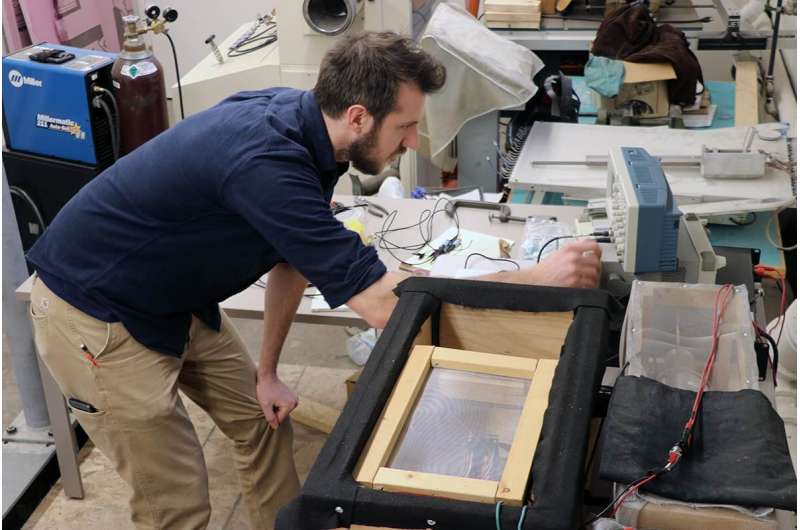Bending microwaves and forbidding frequencies with simulated metamaterials

Using plasma to control microwaves for beaming direct energy toward a specific point is explored for their durability in high-energy electric fields and their reconfigurable structure. High power microwave beams, similar to lasers, can transmit energy at high speeds over long distances, unaffected by wind, gravity, or other forces. Aerospace engineers at the University of Illinois at Urbana-Champaign simulated a metamaterial formed from plasma structures to demonstrate its potential to tune microwave frequencies.
"In the simulation, we focused on atmospheric plasma photonic crystals—a structure formed by plasma columns, about .1 to .8 millimeters in diameter, arranged in columns and rows—think of it as a neatly ordered tiny plasma forest. Ultimately, we're trying to find what knobs to turn—plasma density, column spacing, column radius—to best control the microwave frequency passing through the structure," said Matt Paliwoda, a doctoral student working with Associate Professor Joshua Rovey in the Dept. of Aerospace Engineering at U of I.
Paliwoda's simulation concentrated on predicting the frequency bandgaps that forbid certain frequencies from penetrating a material, by changing the material structure.
"It just blocks it completely. When you send a microwave at a material it might pass through it easily, but it can also be reflected. At these bandgaps, it reflects, forbidding the frequency," he said.
"When you pluck a guitar string, it vibrates at a certain frequency, which depends upon the length of the string," Paliwoda said. "To change the frequency, you might put a clip on one end of the string to shorten the vibrating length and prevent it from vibrating at other frequencies. In the case of the plasma, the spacing between the columns is our string where microwave energy can oscillate while the plasma columns are the fixed ends of the string. In this way, the plasma structure allows the microwave energy to oscillate at certain wavelengths—certain frequencies—and blocks others."
The arrangement or structure of the material can determine how the microwave energy is refracted and directed toward a target. He said photonic crystals and metamaterials have electromagnetic properties not found in natural materials.
Directed energy can be used in military applications but Paliwoda said it may also be used to recharge satellites in space or possibly to move satellites to a higher orbit.
Paliwoda earned a Bachelor of Science degree from the University of Washington, and a master's degree at the Missouri University of Science and Technology, when Rovey was on the faculty there.
"I was interested in the use of plasma actuators over a wing, but when I got to Illinois, I really went down the rabbit hole and started diving into some of the electromagnetics of metamaterials. I've taken a number of microwave courses and also a plasma waves course, so I plan to continue working in this directed energy area, if not specifically with plasma photonic crystals," he said.
The study, "Multiple parameter space bandgap control of reconfigurable atmospheric plasma photonic crystal," written by Matthew C. Paliwoda and Joshua L. Rovey appears in Physics of Plasmas.
More information: Matthew C. Paliwoda et al. Multiple parameter space bandgap control of reconfigurable atmospheric plasma photonic crystal, Physics of Plasmas (2020). DOI: 10.1063/1.5127172
Journal information: Physics of Plasmas
Provided by University of Illinois at Urbana-Champaign




















